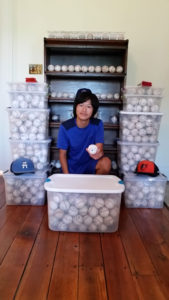
The Ball Hawk
Denny Black
You may not be aware that a new bird-like species was recently discovered. You can only see one during the baseball season each year when it migrates out of winter hiding into every minor and major league ballpark in America. When spotted, it is almost always a male of the species in the approximate age range of nine through adolescence. Its plumage mimics that of a number of baseball birds, including the oriole, cardinal, and blue jay. Its sole purpose is to snag baseballs to carry to its nest. I’m referring to the “Ball Hawk,” and my nephew Edison Hatter is one who recently collected his thousandth baseball on August 12.
Edison’s parents, Ed and Susie Hatter, took him to his first baseball game in 2005 when he was six years old. In 2009, Edison’s Uncle Ron and Aunt Bonnie Albaugh started taking him to the Hagerstown Suns games. In the beginning, Ron and Bonnie had to sit on each side of him because of his fear of getting hit by a foul ball. Who would have known how things would change at a Hagerstown Suns game in 2011, when Edison snagged his first baseball—and a new Ball Hawk was born!
I started to regularly tag along with Edison to ball games during the 2013 season, and soon learned that ball hawking has its own rule book and set of skills. Edison quickly schooled me in the various ball hawking tactics involved in snagging third out balls, home run balls, umpire balls, and dugout balls. I found myself with him at baseball parks, hours before the gates opened for games in order for the Ball Hawk to find baseballs in parking lots during batting practice, and then stand in line to be the first to bolt into a stadium to special locations where practice balls may be hidden. Each tactic requires a Ball Hawk to be strategically located in a stadium at the right place and time during a game. And, it hasn’t hurt my nephew to be able to ask “May I have the baseball, please?” in six languages, as well as sign language (which actually worked to get a baseball on one occasion). It also helps a Ball Hawk to bring along a hat for each team playing the game in order to switch plumage, while hovering over each side of a stadium between innings for baseballs from players.
Not everyone can acquire the skills to become a successful Ball Hawk. You have to be dedicated to arriving hours before each game and staying long after a game ends, in all kinds of weather, to connect with players; and it helps having relatives nuts enough to take you to about fifty games each season. You have to be able to face defeat, like the time when the Ball Hawk and I were sternly directed to leave certain areas of a ball park while chasing baseballs (don’t tell the Ball Hawk’s parents!). For serious reading for Ball Hawks like Edison, a book has been written describing the required skills to succeed, as well as a website where they dutifully document and point score each ball based on the difficulty of the catch. No kidding!
I have witnessed most of Edison’s milestones: Ball 100 (2013 – Arizona Diamondbacks), 200 (2014 – Washington Nationals), 300 and 400 (2014-2015 – Hagerstown Suns), 500 (2015 – Frederick Keys), 600 (2015 – Baltimore Orioles), 700 (2016 – Hagerstown Suns), 800 (2016 – Baltimore Orioles), 900 (2016 – Frederick Keys), and 1,000 (2016 – Toronto Blue Jays).
I was with him in 2015 at Hagerstown when he set his personal record of snagging twenty-six baseballs in one game. I’ve seen him on several occasions run out of Hagerstown’s Municipal Stadium to find a player’s first professional-level home run ball or grand slam ball and then give it to the player after the game. I’ve seen him, over time, give away a quarter of his baseballs to younger kids at games. I stayed with him very late one night after a Frederick Keys game so that he could proudly tell Jonathan Schoop (Orioles 2nd Base), who was there on rehab, that he had acquired an autographed pair of Jonathan’s spikes. Along with all the baseballs, Edison has hawked over twenty-five game-used bats, countless line-up cards, autographed batting gloves (the dirtier the better!), and a stash of baseball cards that most likely includes a future Willie Mays or Mickey Mantle.
I tell Edison that his ball hawking days are numbered now that he is seventeen and can no longer pull off the cute-little-boy routine that works well in getting baseballs from players. He’s working now at passing along his skills to a younger brood of Ball Hawks, like Henry Benchoff and Tyler Caron of Waynesboro. Edison’s parents have dreams of him going into some field of science, but I have different plans for him. I am urging him to become a lawyer and agent for big name sport stars. Then I can continue to tag along with the Ball Hawk to games well into my senior years.
 Edison Hatter, Ball Hawk, collected his thousandth baseball on August 12, 2016.
Edison Hatter, Ball Hawk, collected his thousandth baseball on August 12, 2016.
 Edison Hatter, Ball Hawk, collected his thousandth baseball on August 12, 2016.
Edison Hatter, Ball Hawk, collected his thousandth baseball on August 12, 2016.